Tender meaty seaweed served in a savory, sour, and garlicky sauce. This Chinese seaweed salad is very easy to make and is a perfect cold appetizer to add nutrition to your meal in the summer. {Vegan}
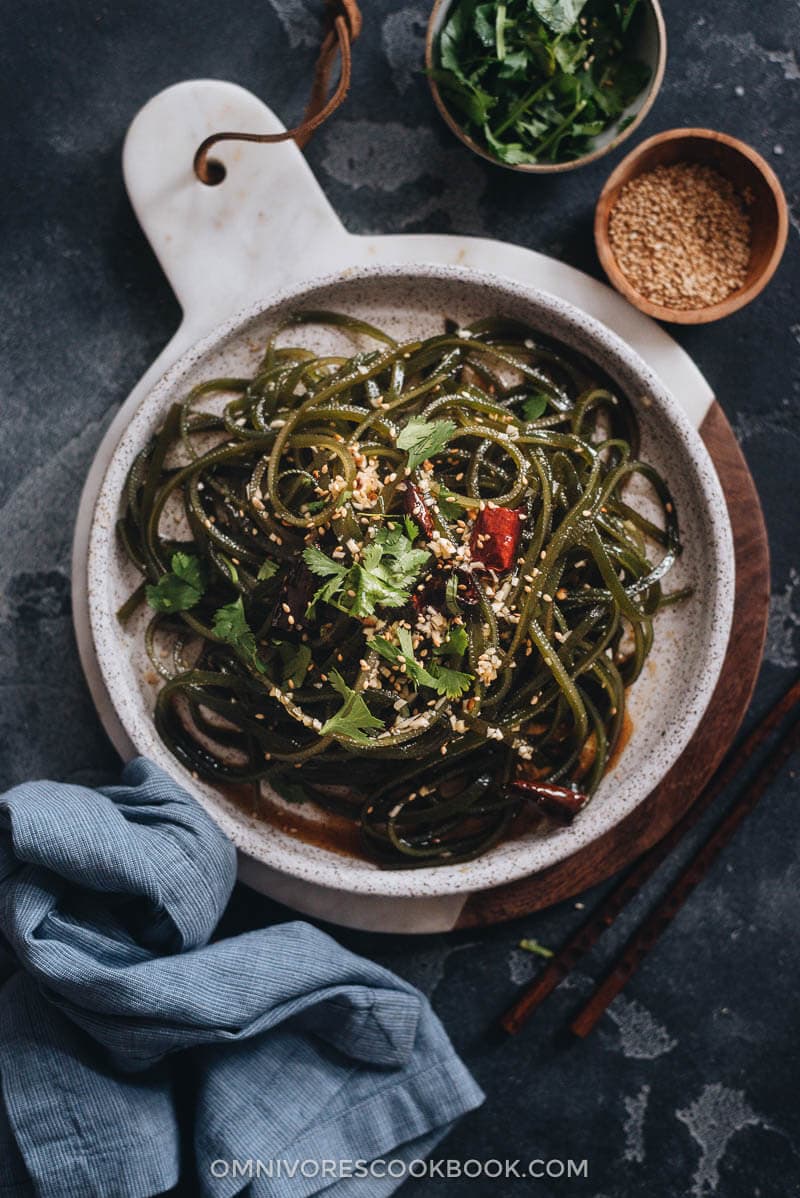
If you think that seaweed is a relatively modern food fad for health junkies and detoxing vegans, you’d be wrong. As an ingredient, seaweed (海带, hǎi dài, sometimes known as kelp) has been eaten in China since prehistoric times and is one of the foods to which Chinese people attribute their first-rate health and longevity.
We add seaweed to various dishes to add texture, flavor, and nutrition. For example, my mom sometimes adds a thin type of seaweed (rehydrated dried wakame) to egg drop soup. She uses thick-cut seaweed strips (like in this recipe) to braise pork to cut the grease and infuse a rich taste into the sauce. The seaweed will end up tasting so good served with the sauce.
One of our summer staples is this cold seaweed salad. It is made with tender and meaty seaweed strips, mixed in a savory and sour sauce and finished up with garlic-infused hot oil. It’s easy to make, tastes good, and stays well after being stored in the fridge. When it’s too hot to make stir-fried veggies, my mom usually serves this quick cold appetizer with congee and dumplings.
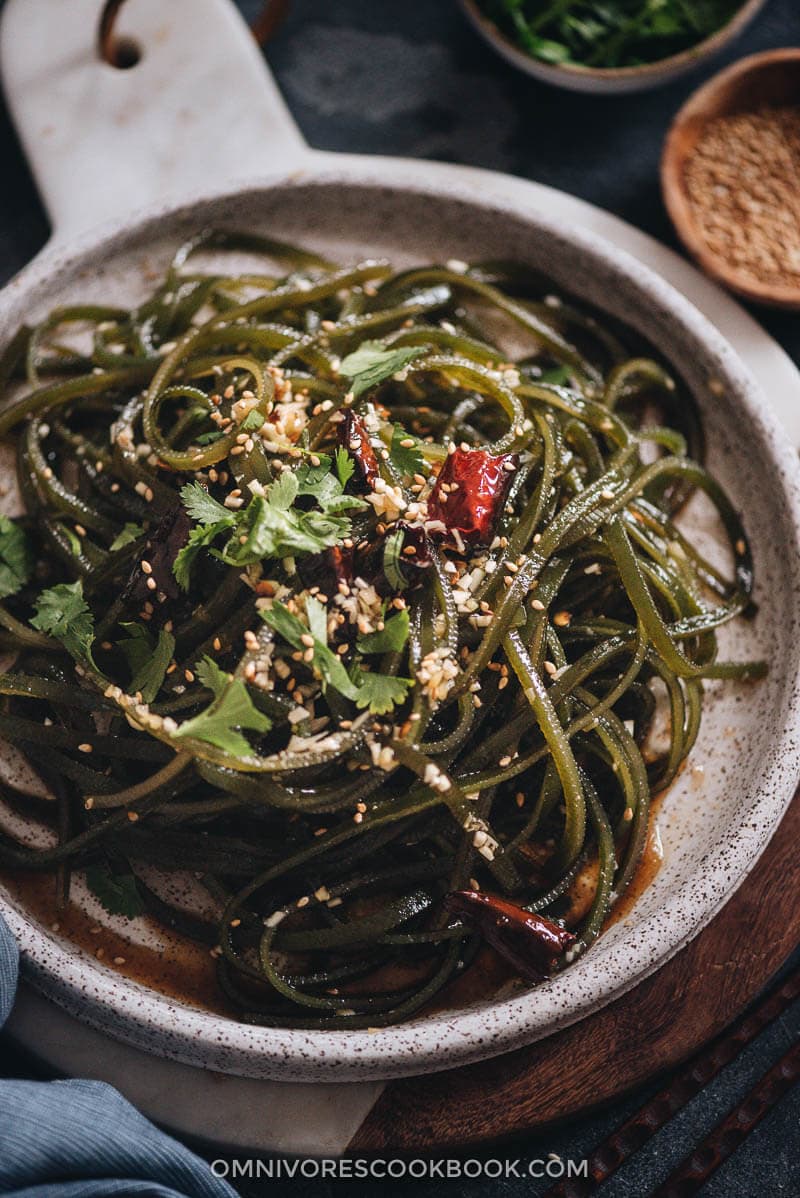
Cooking notes
1. Which type of seaweed to use in Chinese seaweed salad
Edible seaweed comes in all shapes and sizes and is used differently. For example, the thin and tender wakame is often used in Japanese seaweed salad and soup. The Small needle-like hijiki is used in stews and appetizers. The Chinese seaweed salad requires the thick meaty seaweed (or kombu).
Similar to other Chinese vegetables, it is often sold dehydrated (and labeled “kombu”) for longer storage. But you do need to rehydrate it prior to use.
If you’re lucky, you might find fresh seaweed sold in your Asian market or local Chinatown. You can spot it in room temperature (some time refrigerated) as pliant, forest-green sheets, sliced into smaller strips or even tied into adorable little butterfly knots.
This variety is super versatile and can go in a wide array of dishes. On its own, seaweed has a salty, brackish flavor with a pasta-al-dente texture, and is therefore sometimes used as a condiment. Once cooked, however, this flavor mellows and seaweed takes on whatever seasonings you add to it.
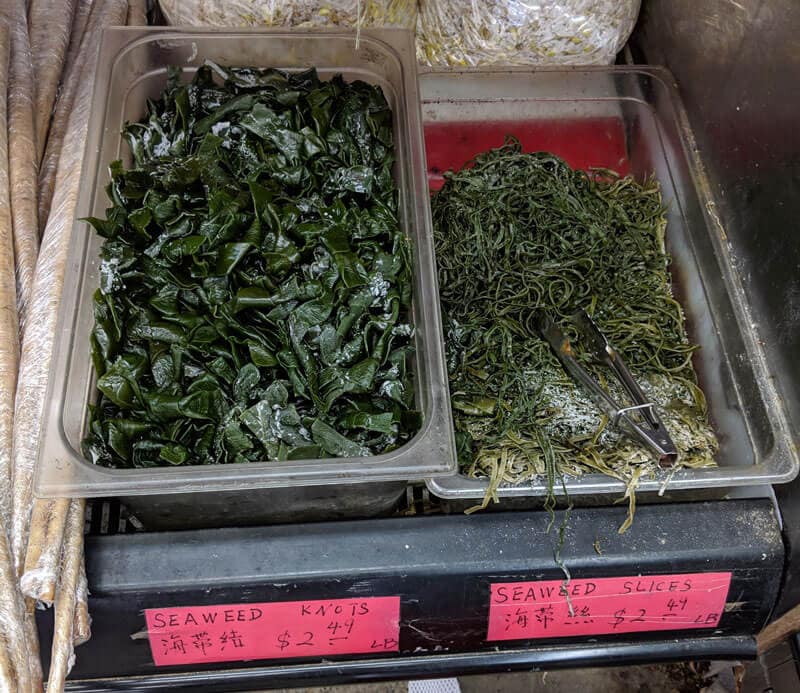
2. How to prepare seaweed
If you bought dried seaweed, you’ll need to rehydrate it before using. To do so, simply submerge the seaweed in hot water and let it sit for 10 to 15 minutes, or until tender.
If you’re using fresh seaweed, you should always rinse it before boiling it. To preserve fresh seaweed, it is usually coated with salt. If you boil it without rinsing, the seaweed will end up tasting very salty.
No matter whether you’re using rehydrated or fresh seaweed, you’ll need to boil it before making the salad. The boiling time varies depending on how the seaweed is cut, its thickness, and the texture. I found that sometimes it takes as little as 10 minutes to cook, and other times it takes up to 20 minutes. The best way to go is to keep an eye on the seaweed and taste it until it reaches your desired texture. When it’s finished cooking, the seaweed should turn tender but not mushy. Like pasta, you can cook it until al dente if you prefer a chewy texture. Or cook it until very tender (which is the way I prefer).
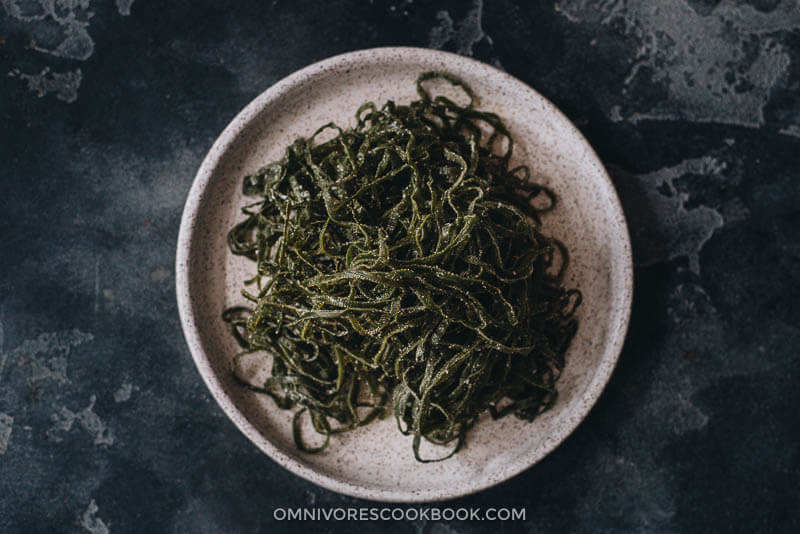
3. Garlic infused oil
It’s a common practice to heat up some oil with dried chili peppers and pour it over the seaweed salad. It will quickly “cook” the ginger and garlic in the sauce, making them less pungent and more aromatic.
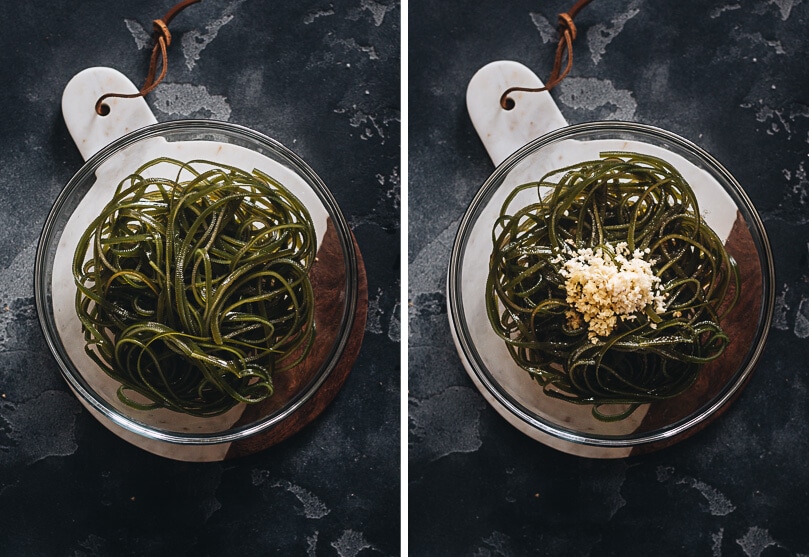
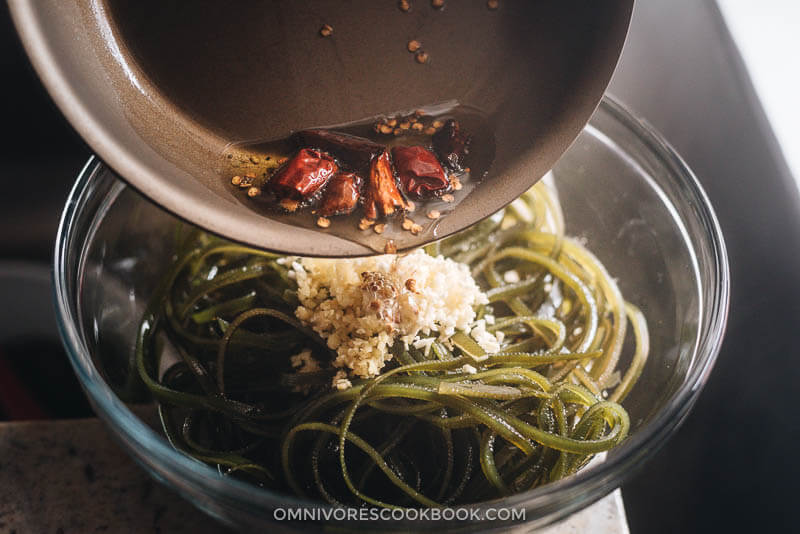
There is a shortcut if you don’t feel like heating up the oil. You can simply add a spoonful of homemade chili oil to the seaweed salad. It’s a condiment I usually have on hand and it further shortens the prep time. The seaweed salad will come out super tasty as well.
We traveled to LA last week. When we returned to New York, the weather had turned to full-bloom summer. I think it’s the perfect time to share this Chinese seaweed salad that’s refreshing and nutritious. I hope you enjoy it!
More cold dishes that are perfect for summer
- Easy Chinese Cucumber Salad (拍黄瓜)
- Wood Ear Mushroom Salad (凉拌木耳)
- Real-Deal Sichuan Chicken in Red Oil Sauce (口水鸡, Saliva Chicken)
- Dan Dan Noodles (担担面)
- Real Deal Sesame Noodles
- Chinese Spinach and Peanut Salad
If you give this recipe a try, let us know! Leave a comment, rate it (once you’ve tried it), and take a picture and tag it @omnivorescookbook on Instagram! I’d love to see what you come up with.
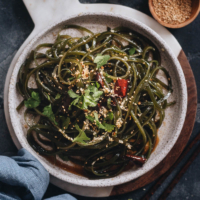
Chinese Seaweed Salad (凉拌海带丝)
Ingredients
- 4 oz. 120 fresh seaweed strips or 1 oz. dried kombu (kelp)
- 1 1/2 tablespoons peanut oil (or vegetable oil)
- 3 dried Chinese chili peppers torn into 2 to 3 pieces
- 1/4 cup loosely packed chopped cilantro for garnish
Sauce
- 1 tablespoon light soy sauce
- 1 tablespoon Chinkiang vinegar
- 1 teaspoon sesame oil , toasted
- 3 cloves garlic , minced
- 1 teaspoon ginger , minced
- 1 teaspoon sugar
- 1/4 teaspoon salt
Instructions
- If you’re using dried kombu, place the kombu in a large bowl and add warm water to cover. Let rehydrate until tender, 10 to 15 minutes. Slice into strips (refer to the blog post above to see how to slice the rehydrated kombu).
- If you’re using fresh seaweed, rinse with tap water and drain.
- Bring a small pot of water to a boil over medium-high heat. Add the seaweed. Let cook for 15 minutes, or until tender. Drain and rinse the seaweed under tap water to cool. Drain thoroughly and transfer to a medium-sized bowl.
- Combine all the sauce ingredients in a small bowl. Stir to mix well. Pour sauce into the bowl with the cooked seaweed. Make sure not to stir it, so all the garlic and ginger will be on top of the seaweed.
- Heat the oil in a small skillet (or saucepaover medium heat until hot. Add the dried chili peppers. Stir a few times until the chili peppers turn dark red. Immediately pour the oil into the bowl with the seaweed, doing your best to pour it directly onto the ginger and garlic. Toss with a pair of tongs to mix well.
- Garnish with the cilantro and toss again.
- Serve at room temperature or cold as an appetizer or side dish.
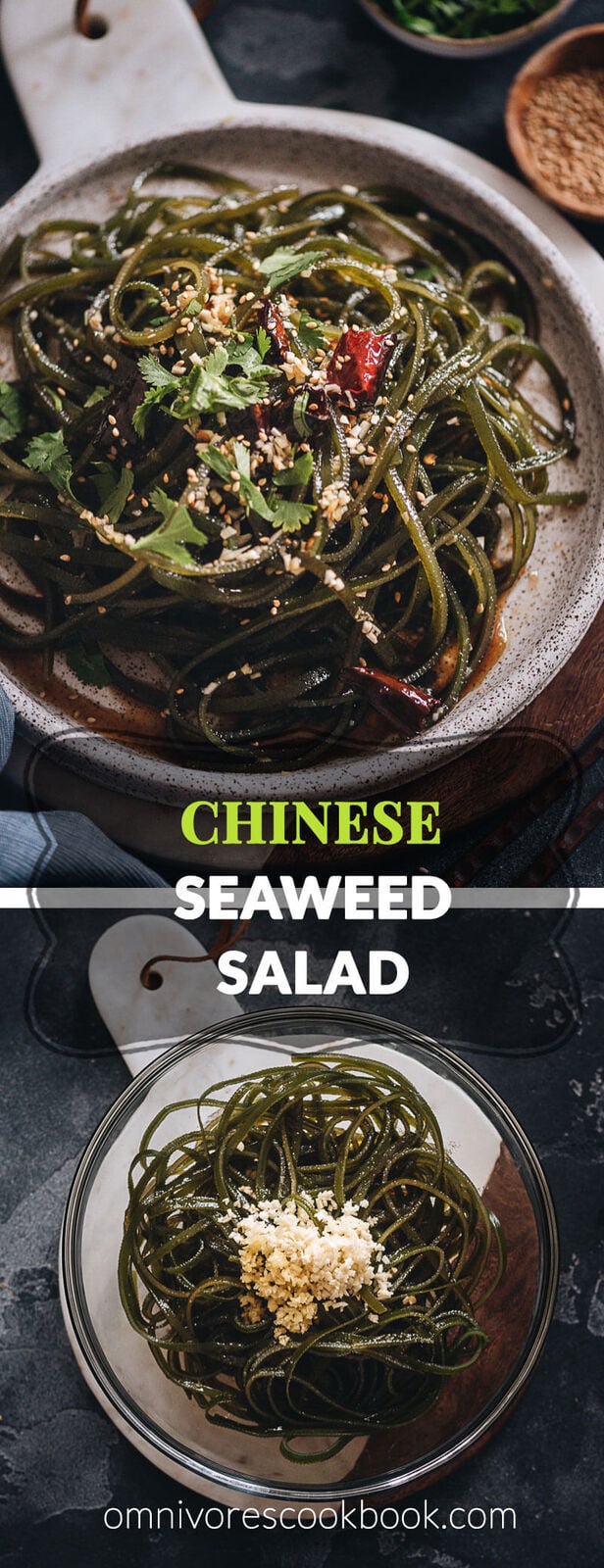













Hi Maggie,
I’m really glad I found your article. I just purchased a bunch of ingredients for a salad I’m making Wednesday night. Bought the ingredients at an Asian market in Brooklyn, Good Fortune Supermarket. They sell fresh seaweed in knots! I think it is kombu. Was searching for wakame, but now that I have your recipe I’m excited to try it out. I made a small batch of salad & dressing tonight but forgot to add the seaweed. :-/ But it’s just as well, bc I didn’t realize till I read your recipe that it must be cooked. So thank you for posting this. Made a lovely vinaigrette with rice vinegar, soy sauce, sesame oil, minced ginger, and erythritol instead of sugar. Toasted sesame seeds. Daikon and other fresh salad ingredients.